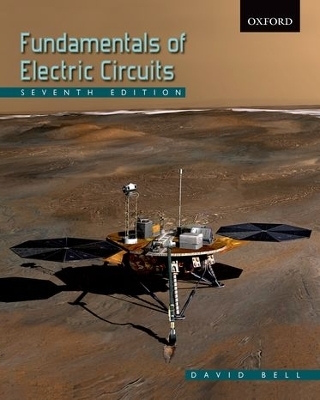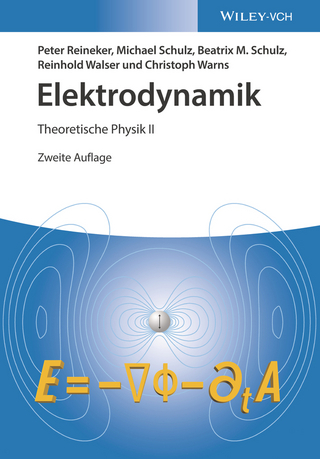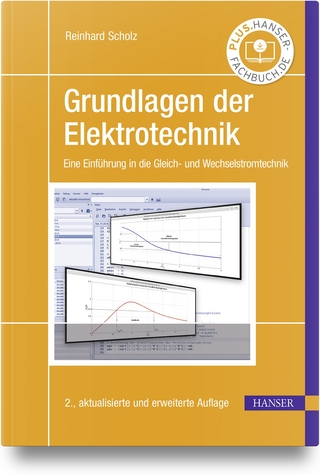
Fundamentals of Electric Circuits
Oxford University Press, Canada (Verlag)
978-0-19-542524-6 (ISBN)
Fundamentals of Electric Circuits, Seventh Edition provides a comprehensive introduction for students taking their first course in electric circuits at the college level. Assuming no previous knowledge, the text begins with explanations of basic concepts, then progresses through simple resistive circuit calculations to complex ac network analysis techniques. Students are also taught practical skills, including how to use common electrical instruments. Straightforward, informatively captioned illustrations demonstrate and clarify each new concept and analysis method. Learning is reinforced with an array of calculation examples, review questions, and problem sets. This text has everything to give students a solid foundation in the full spectrum of electric circuit topics.
David A. Bell is a professional engineer who was employed as a circuit design specialist in the electronics industry for many years before becoming a professor at Lambton College of Applied Arts and Technology
1. Basics of Electricity ; Objectives ; Introduction ; 1-1 Electrification by Friction ; 1-2 Voltage, Current, and Resistance ; 1-3 Basic Source of Electricity ; 1-4 Electric Lamp ; 1-5 Electric Circuit ; 1-6 Current Direction ; 1-7 Direct Current and Alternating Current ; 1-8 Electric shock ; Review Questions ; Summary of Important Terms ; 2. Measuring Current, Voltage, and Resistance ; Objectives ; Introduction ; 2-1 Metric Prefixes and Engineering Notation ; 2-2 Current Measurement ; 2-3 Voltage Measurement ; 2-4 Resistance Measurement ; 2-5 Instrument Accuracy and Precision ; Summary of Basic Electrical Instrument Characteristics ; Review Questions ; Problems ; Practice Problem Answers ; 3. Ohm's Law and Electrical Calculations ; Objectives ; Introduction ; 3-1 Resistance ; 3-2 Ohm's Law ; 3-3 Application of Ohm's Law ; 3-4 Conductance ; 3-5 Electrical Power and Energy ; Summary of Formulas ; Review Questions ; Problems ; Practice Problem Answers ; 4. Conductors, Insulators, and Resistors ; Objectives ; Introduction ; 4-1 Conductors ; 4-2 Insulators ; 4-3 Conductor Resistivity ; 4-4 Temperature Effects on Conductors ; 4-5 Resistor Construction and Power Ratings ; 4-6 Temperature Coefficients of Resistors ; 4-7 Resistor Color Code ; Summary of Formulas ; Review Questions ; Problems ; Practice Problem Answers ; 5. Series Resistor Circuits ; Objectives ; Introduction ; 5-1 Series Resistor Circuit ; 5-2 Voltages in a Series Circuit (Kirchhoff's Voltage Law) ; 5-3 Voltage Divider ; 5-4 Potentiometer ; 5-5 Power in a Series Circuit ; 5-6 Voltage Dropping and Current Limiting ; 5-7 Open Circuits and Short Circuits in Series Circuits ; Summary of Formulas ; Review Questions ; Problems ; Practice Problem Answers ; 6. Parallel Resistor Circuits ; Objectives ; Introduction ; 6-1 Parallel Resistor Circuit (Kirchhoff's Current Law) ; 6-2 Parallel Equivalent Circuit ; 6-3 Conductances in Parallel ; 6-4 Current Divider ; 6-5 Power in Parallel Circuits ; 6-6 Open Circuits and Short Circuits in a Parallel Circuit ; Summary of Formulas ; Review Questions ; Problems ; Practice Problem Answers ; 7. Series- Parallel Resistor Circuits ; Objectives ; Introduction ; 7-1 Series-Parallel Resistor Circuits ; 7-2 Currents in a Series-Parallel Circuit ; 7-3 Voltage Drops in a Series-Parallel Circuit ; 7-4 Ladder Networks ; 7-5 Analysis of Series-Parallel Resistor Circuits ; 7-6 Troubleshooting Series-Parallel Circuits ; Problems ; Practice Problem Answers ; 8. Network Analysis Techniques ; Objectives ; Introduction ; 8-1 Voltage Sources and Current Sources ; 8-2 Network Analysis Using Kirchhoff's Laws ; 8-3 Loop Equations (Mesh Equations) ; 8-4 Nodal Analysis ; 8-5 Delta-Y Transformations ; 8-6 Dependent Voltage and Current Sources ; Summary of Formulas ; Review Questions ; Problems ; Practice Problem Answers ; 9. Network Theorems ; Objectives ; Introduction ; 9-1 The Superposition Theorem ; 9-2 Thevenin's Theorem ; 9-3 Norton's Theorem ; 9-4 Millman's Theorem ; 9-5 Maximum Power Transfer Theorem ; Review Questions ; Problems ; Practice Problem Answers ; 10. Voltage Cells, Batteries, and DC Power Supplies ; Objectives ; Introduction ; 10-1 Simple Voltage Cell ; 10-2 Voltage Cell Characteristics ; 10-3 Miscellaneous Voltage Cells ; 10-4 Voltage Cells in Series ; 10-5 Voltage Cells in Parallel ; 10-6 Voltage Cells in Series-Parallel ; 10-7 Lead-Acid Battery ; 10-8 DC Power Supplies ; Summary of Formulas ; Review Questions ; Problems ; Practice Problem Answers ; 11. Magnetism ; Objectives ; Introduction ; 11-1 Magnetic Field ; 11-2 Electromagnetism ; 11-3 Theory of Magnetism ; 11-4 Magnetic Flux and Flux Density ; 11-5 Magnetomotive Force and Magnetic Field Strength ; 11-6 Force on Current-Carrying Conductors ; Summary of Formulas ; Review Questions ; Problems ; Practice Problem Answers ; 12. Magnetic Circuits ; Objectives ; Introduction ; 12-1 Reluctance and Permeability ; 12-2 Permeability of Free Space ; 12-3 Solenoid ; 12-4 Relative Permeability ; 12-5 Composite Magnetic Circuits ; 12-6 Force between Two Magnetic Surfaces ; 12-7 Magnetization Curves, Hysteresis, and Eddy Currents ; Summary of Formulas ; Review Questions ; Problems ; Practice Problem Answers ; 13. DC Measuring Instruments ; Objectives ; Introduction ; 13-1 Basic Ammeters ; 13-2 Basic Voltmeters ; 13-3 Basic Ohmmeters ; 13-4 Electronic Voltmeters (Analog and Digital) ; 13-5 Electronic Ammeters and Voltmeters ; 13-6 Measuring Resistance by Ammeter and Voltmeter ; 13-7 The Megohmmeter ; 13-8 Power Measurement ; 13-9 The Wheatstone Bridge ; Summary of Formulas ; Review Questions ; Problems ; Practice Problem Answers ; 14. Inductance ; Objectives ; Introduction ; 14-1 Electromagnetic Induction ; 14-2 Induced EMF and Current ; 14-3 Self-Inductance ; 14-4 Mutual Inductance ; 14-5 Types of Inductors ; 14-6 Energy Stored in an Inductive Circuit ; 14-7 Inductors in Series and in Parallel ; Summary of Formulas ; Review Questions ; Problems ; Practice Problem Answers ; 15. Capacitance ; Objectives ; Introduction ; 15-1 Electric Charge Storage ; 15-2 Electric Field ; 15-3 Capacitance and Capacitor Dimensions ; 15-4 Capacitor Types and Characteristics ; 15-5 Capacitors in Series and in Parallel ; 15-6 Energy Stored in a Charged Capacitor ; Summary of Formulas ; Review Questions ; Problems ; Practice Problem Answers ; 16. Inductance and Capacitance in DC Circuits ; Objectives ; Introduction ; 16-1 RL Circuit Operation ; 16-2 Instantaneous Current and Voltage in RL Circuits ; 16-3 Open-Circuiting an Inductive Circuit ; 16-4 RL Circuit Waveforms ; 16-5 RC Circuit Operation ; 16-6 Instantaneous Current and Voltage in RC Circuits ; 16-7 Discharging a Capacitor ; 16-8 RC Circuit Waveforms ; Summary of Formulas ; Review Questions ; Problems ; Practice Problem Answers ; 17. Alternating Current and Voltage ; Objectives ; Introduction ; 17-1 Generation of Alternating Voltage ; 17-2 Sine Wave ; 17-3 Frequency, Phase Angle, and Wavelength ; 17-4 Resistive Load with AC Supply ; 17-5 Peak, Average, and RMS Values of Sine Waves ; 17-6 Oscilloscopes ; 17-7 AC Function Generator ; 17-8 AC Voltmeters ; 17-9 AC Electronic voltmeters ; Summary of Formulas ; Review Questions ; Problems ; Practice Problem Answers ; 18. Phasors and Complex Numbers ; Objectives ; Objectives ; 18-1 Phasor Representation of Alternating Voltage ; 18-2 Addition and Subtraction of Phasors ; 18-3 Polar and Rectangular Forms, the j Operator ; 18-4 Mathematics of Complex Quantities ; Summary of Formulas ; Review Questions ; Problems ; Practice Problem Answers ; 19. Inductance and Capacitance in AC Circuits ; Objectives ; Introduction ; 19-1 Alternating Current and Voltage in an Inductive Circuit ; 19-2 Inductive Reactance and Susceptance ; 19-3 Alternating Current and Voltage in a Capacitive Circuit ; 19-4 Capacitive Reactance and Susceptance ; 19-5 Series RL Circuits ; 19-6 Series RC Circuits ; 19-7 Series RLC Circuits ; 19-8 Parallel RL Circuits ; 19-9 Parallel RC Circuits ; 19-10 Parallel RLC Circuits ; Summary of Formulas ; Review Questions ; Problems ; Practice Problem Answers ; 20. Series and Parallel AC Circuits ; Objectives ; Introduction ; 20-1 Series-Connected Impedances ; 20-2 AC Voltage Divider ; 20-3 Impedances in Parallel ; 20-4 AC Current Divider ; 20-5 Series-Parallel Impedances ; 20-6 Series and Parallel Equivalent Circuits ; Summary of Formulas ; Problems ; Practice Problem Answers ; 21. Power in AC Circuits ; Objectives ; Introduction ; 21-1 Power Dissipated in a Resistance ; 21-2 Power in an Inductance ; 21-3 Power in a Capacitance ; 21-4 True Power and Reactive Power ; 21-5 Power in RL and RC Circuits ; 21-6 Power Factor ; 21-7 AC Wattmeter ; Summary of Formulas ; Review Questions ; Problems ; Practice Problem Answers ; 22. AC Network Analysis and Theorems ; Objectives ; Introduction ; 22-1 AC Voltage Sources and Current Sources ; 22-2 Kirchhoff's Laws for AC Circuits ; 22-3 AC Circuit Loop Equations (Mesh Equations) ; 22-4 Superposition Theorem Applied to AC Networks ; 22-5 Nodal Analysis for AC Circuits ; 22-6 Thevenin's Theorem Applied to AC Circuits ; 22-7 Norton's Theorem Applied to AC Circuits ; 22-8 Maximum Power Transfer Theorem Applied to AC Circuits ; 22-9 Delta-Wye Transformations for AC Networks ; 22-10 AC Bridges ; Summary of Formulas ; Review Questions ; Problems ; Practice Problem Answers ; 23. Resonance ; Objectives ; Introduction ; 23-1 Series Resonance ; 23-2 Tuning for Resonance ; 23-3 Q Factor of a Series Resonant Circuit ; 23-4 Bandwidth of a Series Resonant Circuit ; 23-5 Parallel Resonance ; 23-6 Q Factor for Parallel LC Circuits ; 23-7 Resonance Frequency for Parallel LC Circuits ; 23-8 Resistance Damping of Parallel LC Circuits ; 23-9 Tuned Coupled Coils ; Summary of Formulas ; Review Questions ; Problems ; Practice Problem Answers ; 24. Filters ; Objectives ; Introduction ; 24-1 Basic Filter Types ; 24-2 Power Measurement in Decibels ; 24-3 RC Low-Pass Filters ; 24-4 RC High-Pass Filters ; 24-5 Filter Frequency Response Graphs ; 24-6 RL Low-Pass and High-Pass Filters ; 24-7 Band-Pass Filters ; 24-8 Notch Filters ; Summary of Formulas ; Review Questions ; Problems ; Practice Problem Answers ; 25. Transformers ; Objectives ; Introduction ; 25-1 Principle of Transformer Operation ; 25-2 EMF Equation ; 25-3 Transformer on No-Load ; 25-4 Transformer on Load ; 25-5 Referred Resistance and Reactance ; 25-6 Transformer Voltage Regulation ; 25-7 Transformer Efficiency ; 25-8 Open-Circuit and Short-Circuit Tests ; 25-9 Autotransformer, Current Transformer, and Audio Transformer ; Summary of Formulas ; Review Questions ; Problems ; Practice Problem Answers ; 26. Three-Phase AC Systems ; Objectives ; Introduction ; 26-1 Generation of Three-Phase Voltages ; 26-2 Y-Connected Generator ; 26-3 Delta-Connected Generator ; 26-4 Y-? and Y-Y Systems ; 26-5 Phase Sequence ; 26-6 Power in Three-Phase Systems ; 26-7 Power Factor Correction ; 26-8 Three-Phase Power Measurement ; Summary of Formulas ; Review Questions ; Problems ; Practice Problem Answers ; 27. Nonsinusoidal Waveforms ; Objectives ; Introduction ; 27-1 Miscellaneous Waveforms ; 27-2 Harmonics in Waveforms ; 27-3 Harmonic Analysis ; 27-4 RMS Value of Nonsinusoidal Waveforms ; 27-5 Nonsinusoidal Voltage as a Circuit Input ; Summary of Formulas ; Review Questions ; Problems ; Practice Problem Answers ; 28. Circuit Analysis by Computer ; Objectives ; Introduction ; 28-1 Series Resistor Circuit ; 28-2 Series-Parallel Resistor Circuits ; 28-3 DC Network Analysis ; 28-4 Variable Load Resistor ; 28-5 Transient Analysis ; 28-6 AC Network Analysis ; 28-7 Resonant Circuit Analysis ; 28-9 Filter Frequency Response ; Problems ; Appendix 1: Circuit Symbols ; Appendix 2: The International System of Units ; Appendix 3: Unit Conversion Factors ; Appendix 4: American Wire Gauge Sizes and Metric Equivalents ; Appendix 5: Resistor Color Code ; Appendix 6: Resistor and Capacitor Values ; Answers to odd-numbered problems ; Index
| Erscheint lt. Verlag | 5.2.2009 |
|---|---|
| Zusatzinfo | 300 figures, 5 tables |
| Sprache | englisch |
| Maße | 211 x 262 mm |
| Gewicht | 1752 g |
| Themenwelt | Naturwissenschaften ► Physik / Astronomie ► Elektrodynamik |
| Technik ► Elektrotechnik / Energietechnik | |
| ISBN-10 | 0-19-542524-3 / 0195425243 |
| ISBN-13 | 978-0-19-542524-6 / 9780195425246 |
| Zustand | Neuware |
| Haben Sie eine Frage zum Produkt? |
aus dem Bereich


